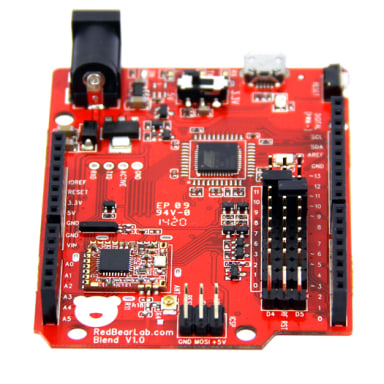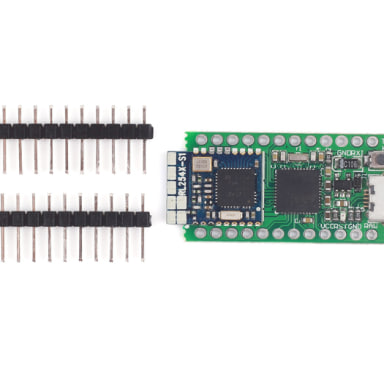RedBearLab Blend V1.0 Arduino ATmega32u4 BLE
- Utilize Nordic Bluetooth Smart SDK for Arduino
- Software development using Arduino IDE or codebender
- Works with our free Android App and iOS App
- Support 5V and 3.3V operating voltage
- Selectable REQN and RDYN pins, from pin 0 to 3, 6 to 11
- Flexible RF RESET pin, pin 4 or 5
- Over-the-Air download of sketch to Blend (available soon)
- Besides the on-board PCB antenna, option to use SMA connector for external antenna (soldering is required)
原廠連結:http://redbearlab.com/blend/
Features
- Utilize Nordic Bluetooth Smart SDK for Arduino
- Software development using Arduino IDE or codebender
- Works with our free Android App and iOS App
- Support 5V and 3.3V operating voltage
- Selectable REQN and RDYN pins, from pin 0 to 3, 6 to 11
- Flexible RF RESET pin, pin 4 or 5
- Over-the-Air download of sketch to Blend (available soon)
- Besides the on-board PCB antenna, option to use SMA connector for external antenna (soldering is required)


Getting Started Guide
We recommend using Codebender, an online development and collaboration platform for all Arduino users, please read to our Quick Start with Codebender to start playing with your Blend in just a few easy steps.
We have also prepared a detail guide Getting Started with Blend to show you how to program your Blend with Arduino IDE.
Description
Blend is an integrated developement board, we have "blend"ed Arduino with Bluetooth 4.0 Low Energy (aka BLE or Bluetooth Smart) into a single board. It is targeted for makers to develop low power Internet-Of-Things (IoT) projects quickly and easily.
Blend is 100% compatible with sketches and Shields that work with Arduino Leonardo. The micro-controller unit (MCU) is Atmel ATmega32U4 and the BLE chip is Nordic nRF8001. Blend runs as BLE peripheral role only, it allows BLE central role devices to establish connection with.
Current supported BLE central devices:
iOS 7 or 8
- iPhone 4s
- iPhone 5/6 (all models)
- iPod touch 5
- iPad 3/4/mini/Air
Android 4.3 or above (4.4 recommended for stability) with Bluetooth 4.0 hardware support
- Nexus 4
- Nexus 5
- Nexus 7
- other compatible Android devices reported by our users
(please report any other Android devices supported)
Windows Phone 8.1
- Nokia Lumia 630
- (please report any other Windows Phone devices supported)
Windows 8.1 with built-in Bluetooth 4.0 or USB dongle
Mac OSX 10.9.2 with built-in Bluetooth 4.0 or USB dongle
Linux with BlueZ 5.1 with built-in Bluetooth 4.0 or USB dongle
How It Works
- The nRF8001 chip communicates with ATmega32U4 through the ACI (Application Controller Interface). The ACI is similar to SPI but not actually works as SPI. SPI is consist of MOSI, MISO, SCK and SS, whereas ACI is consist of MOSI, MISO, SCK, REQN and RDYN.
- Since the nRF8001 chip may receive data anytime even not selected by SPI master (Atmega32U4), so the SS line is not needed.
- For the ACI, data exchange still through MOSI and MISO, and SCK provides the clock generated by master.
- When master wants to request data from BLE Shield, it puts the REQN to low until RDYN line is put to low by BLE Shiled, and then master generates the clock to read out the data. After reading out the data, master will release the REQN and BLE Shield release the RDYN, put them to high.
- If the nRF8001 has data to transmit to master, it will put the RDYN to low to indicate master, even though the master has not requested data and REQN is idle. If the master detectes a low level condition on RDYN, it will put REQN to low and generate the clock to read out the data. After reading out the data, both REQN and RDYN will be put to high. Note that REQN is controlled by master while RDYN is controlled by the nRF8001 chip.
Operate at 3.3V or 5V
According to the Atmega32U4 specification, the MCU can run at either 8MHz@3.3V or 16MHz@5V. Normally, you should set the voltage selection switch to 5V to run the board at 16MHz. However if you need to connect to shields or external components, such as sensors or MCU, which accept 3.3V only, you should change the operating voltage to 3.3V using the voltage selection switch.
Note that while Blend is running at 3.3V, the Atmega32U4 will still run at 16MHz which is outside Atmel's specification, the CPU is overclocked (we have not seen any issue so far).
Support
For questions about Nordic Bluetooth low energy SDK for Arduino,
please visit Nordic Developer Zone
All other questions regarding Blend, please visit our Blend Forum
Technical Details
Nordic nRF8001 Bluetooth Low Energy IC
- Support Peripheral (Slave) role operation only – nRF8001 IC limitation
- Proprietary simple serial interface – Application Controller Interface (ACI)
- Please refer to Nordic’s nRF8001 Product Specification for more details
Application Controller Interface (ACI)
- The ACI enables an application controller to communicate with nRF8001
- The physical ACI interface on nRF8001 consists of five pins. All ACI data and exchanges use a standard SPI interface, with nRF8001 using a mode 0 slave interface to the application controller
- However, nRF8001 does not behave as a pure SPI slave device; nRF8001 can receive new data over-the-air at any time or be busy processing a connection event or new data. Consequently, the traditional CSN signal used to initiate an SPI transaction is replaced by two active low hand-shake signal; RDYN and REQN
| Signal | Arduino | nRF8001 | Description |
|---|---|---|---|
| MISO | Input | Output | SPI: Master In Slave Out |
| MOSI | Output | Input | SPI: Master Out Slave In |
| SCK | Output | Input | SPI: Serial data Clock |
| REQN | Output | Input | Application controller to nRF8001 handshake signal |
| RDYN | Input | Output | nRF8001 to application controller handshake signal |
Blend Layout
A. Reset button - ATmega32U4 & nRF8001
B. 3.3V/5V voltage selection switch
C. Indicator LED for power on, RX, TX and pin 13
D. Atmel ATmega32U4
E. Factory testing pins
F. REQN and RDYN selection pins from pin 0 to 3, 6 to 11
G. Optional Pin to control the nRF8001 reset
H. RedBearLab nRF8001 Module
I. SPI interface for nRF8001 or other SPI usage
J. Onboard antenna
K. External antenna connector
Blend Pinout
Specification
| Microcontroller | Atmel ATmega32U4 | ||
| Wireless Chip | Nordic nRF8001 | ||
| Operating Voltage | 3.3V or 5V | ||
| Input Voltage | 5V (USB) 6.5-12V (DC input or VIN) |
||
| Note: Use only one power source at a time, otherwise you will damage the board. |
|||
| Clock Speed | 16MHz | ||
| Connectivity | Bluetooth 4.0 Low Energy micro-USB Serial (TX/RX) I2C SPI |
||
| Flash Memory | 32KB (of which 4 KB used by bootloader) | ||
| SRAM | 2.5KB | ||
| EEPROM | 1KB | ||
| Dimensions | 73 x 54 x 12mm (120 x 73 x 25mm with packaging) | ||
| Weight | 19g (37g with packaging) | ||
| I/O Pins | 20 | ||
| Pin Functions | 0 | Digital I/O or Serial RX | |
| 1 | Digital I/O or Serial TX | ||
| 2 | Digital I/O or I2C SDA | ||
| 3 | Digital I/O or PWM or I2C SCL | ||
| 4 | Digital I/O or Analog Input (A6) | ||
| 5 | Digital I/O or PWM | ||
| 6 | Digital I/O or PWM | ||
| 7 | Digital I/O or Analog Input (A7) | ||
| 8 | Digital I/O or Analog Input (A8) | ||
| 9 | Digital I/O or PWM or Analog Input (A9) | ||
| 10 | Digital I/O or PWM or Analog Input (A10) | ||
| 11 | Digital I/O or PWM | ||
| 12 | Digital I/O or Analog Input (A11) | ||
| 13 | Digital I/O or PWM, also connected to an LED | ||
| Note: The pins that you have selected for REQN, RDYN and RF-RESET are not available for program usage. | |||
| A0 | Digital I/O or Analog Input | ||
| A1 | Digital I/O or Analog Input | ||
| A2 | Digital I/O or Analog Input | ||
| A3 | Digital I/O or Analog Input | ||
| A4 | Digital I/O or Analog Input | ||
| A5 | Digital I/O or Analog Input | ||
| MOSI | SPI Master-Output-Slave-Input | ||
| MISO | SPI Master-Input-Slave-Output | ||
| SCK | SPI Clock | ||
| Note: SPI is enabled by default for nRF8001. | |||
資料來源:https://www.seeedstudio.com/Blend-V1.0---a-single-board-integrated-with-Arduino-and-BLE-p-1918.html
Description
Software development using Arduino IDE
Works with our free Android AppandiOS App
Support 5V and 3.3V operating voltage
Selectable REQN and RDYN pins, from pin 0 to 3, 6 to 11
Flexible RF RESET pin, pin 4 or 5
Over-the-Air download of sketch to Blend (available soon)
Besides the on-board PCB antenna, option to use SMA connector for external antenna (soldering is required)
| Microcontroller | Atmel ATmega32U4 |
| Wireless Chip | Nordic nRF8001 |
| Operating Voltage | 3.3V or 5V |
| Input Voltage |
5V (USB) 6.5-12V (DC input or VIN) |
|
Note: Use only one power source at a time,
otherwise you will damange the board.
|
|
| Clock Speed | 16MHz |
| Connectivity |
Bluetooth 4.0 Low Energy
micro-USB
Serial (TX/RX)
I2C
SPI
|
| Flash Memory | 32KB (of which 4 KB used by bootloader) |
| SRAM | 2.5KB |
| EEPROM | 1KB |
| Dimensions | 73 x 54 x 12mm (120 x 73 x 25mm with packaging) |
| Weight | 19g (37g with packaging) |
| I/O Pins | 20 |
Technical Details
| Dimensions | 114mm x 72mm x 23mm |
| Weight | G.W 34g |
| Battery | Exclude |
Part List
| Blend V1.0 - a single board integrated with Arduino and BLE | 1 |























